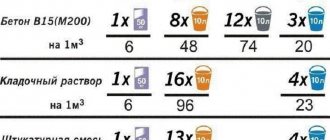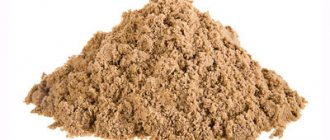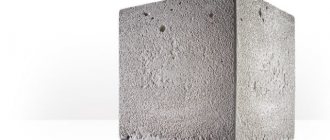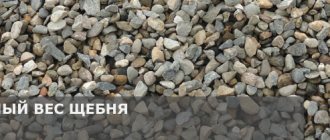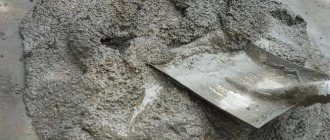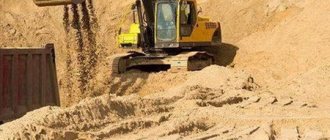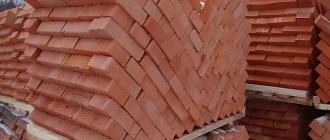Construction work requires a large amount of sand. It is used for the production of concrete and mortar, creating foundations and blind areas, for backfilling pits and trenches. Sand is used in road construction and for the construction of drainage systems; it is part of various building mixtures - plaster, asphalt concrete, paints, etc. Sand can be purchased in bulk (loose) and in bags of various sizes. The most commonly used bags are those that can hold 50 kilograms of sand. Before ordering a supply of sand, you need to know exactly how many cubic meters of sand are in a 50 kg bag? This will help you avoid making mistakes when calculating the need for sand to complete a certain amount of work. Knowing how many bags of sand are in 1 cube, you can easily calculate how many bags should be purchased.
How many bags of cement are needed for 1 cubic meter of concrete?
It is better to purchase building materials in bags packaged in 50 kg bags - this makes it easier to calculate the proportions of the components. For example, for making a concrete mixture for a foundation, the recommended ratio of cement, sand, crushed stone and water is 1: 3: 5: 0.5 . This means that for 1 bucket of cement you need to take 3 buckets of sand, 5 buckets of crushed stone (gravel) and half a bucket of water.
To calculate the cement consumption per 1 m2 of screed, use the calculator. First you need to calculate the required volume of solution: multiply the thickness by the surface area. So, to make a screed 30 mm thick for a room with an area of 15 m2 you will need: 15 × 0.03 = 0.45 m3 of concrete.
For screeding, it is recommended to use concrete mortar M200, that is, you need 445 kg of cement M400 per 1 m3. This means that the consumption is: 0.45 × 445 = 200.25 kg (four bags).
Application
Sand has a wide range of uses, the main one being the construction of various kinds of objects, highways .
Car roads
But these are not the only options where such material can be used. Sand is also used in medicine , but not all of it, only quartz and sea sand, as well as in the agricultural industry, in housing (sprinkled on ice in the winter).
In addition, in recent years, sand has found its use in landscape decoration.
In landscape decoration
Bulk material is also used during the production of flooring and in welding production. River sand can be found even in a simple home aquarium.
If we talk about medicine, today such treatment as psammotherapy has become popular. But here you can only use three types of sand: quartz, mineral and sea sand. This procedure is carried out only in the fresh air, somewhere in sanatoriums. It is prescribed for spasms, inflammation, and so on.
Properties, forms and types
The sand itself is not homogeneous, as it consists of different grains , and based on this it can be divided into:
- coarse sand, containing grains with a diameter of 0.5-5mm;
Coarse grain
- medium-grained bulk material, consists of grains 0.05-0.25mm;
Medium grain
- the finest type of sand, fine-grained - 0.25-0.05mm.
Fine grain
Sand differs not only in color, the shape of its grains can also be different: rounded, angular, sharp, and so on. The shape depends on the transport of material by wind or water.
Speaking about its composition , it is also divided into several main types:
- sand, which consists of a single mineral. For example, quartz sand or carbonate sand. In the literature you can find the name - oligomictic;
- sand, which consists of different minerals. It could be quartz sand with impurities. In technical dictionaries you can find the name – polymictic.
Density
Almost all building materials are either artificial or natural. Speaking about the last option, it consists of grains with a size of 0.16-5 mm, and its bulk density is in the range of 1300-1500 kn/m3. Sand of natural origin is most often used in construction and everyday life.
Whatever type of sand you choose, you need to know that it has one very good property - absorb moisture , removing it from other finished products, while increasing its flowability. It is logical that if the volume changes, then the bulk density itself changes, which in turn depends on how the humidity changes.
If, for example, humidity fluctuates in the range of 3-10%, then this material differs from dry material in its density.
It is worth understanding that a grain of sand, which is covered with a layer of water, increases in volume, and this leads to an increase in the density of the sand.
When calculating construction work, it is worth taking this into account (bulk density) and knowing how the density changes as humidity increases. It is the level of sand quality that depends on its density.
The density of cement must be known so that you can correctly assess the reliability of the future mortar and its strength. Here you can get acquainted with the characteristics of cement density.
Aerated concrete, which is used in the construction of walls, has long become quite in demand in the modern construction of buildings and houses. By clicking on the link, you will become familiar with plastering walls made of aerated concrete.
A screed is a mixture of sand and cement used to make a floor base. Dry floor screed is fast, high quality and reliable.
This is a necessary characteristic, especially when it comes to professional construction, since this property affects the strength of the object and, accordingly, its service life.
The density of sand is already a known figure and you don’t need to count it, but in order to calculate the volume of sand in a ton, you need to know the mass, and knowing it you can find out by knowing the density. The calculation is carried out using the formula m=V*p. Obviously, v is the volume of sand, and p is the density.
There are two types of sand density:
- Bulk.
- True.
Density
This value is influenced by some factors that are worth considering:
- the amount of impurities in the material itself (clay, dust, debris);
- immediate humidity level. A fairly humid factor, it is this that influences the density. If the humidity increases to 10%, then the density of the sand decreases, as different lumps form in it. But in such a situation the volume increases;
- sand particle size. Since sand consists of small grains, to take into account its density, you need to know the fraction of the material;
- It is also important to take into account the type of sand , which depends on where the sand is mined.
For more information about the density of sand, see the video below:
Volume calculation
Of course, it is difficult to accurately calculate the volume of sand per ton, since for this you need to know the characteristics described above. But to know these numbers it is necessary to conduct research in the laboratory. To have exact numbers, and not what we see in tables (rounded).
Parameters such as humidity, filtration and compaction change depending on the weather. This is what affects the exact calculation of the volume of sand, but it is extremely difficult to do this.
To make the task easier for builders, it was decided to take approximate figures for calculation:
- moisture resistance – 7%;
- density level – 1600 kg/m3.
Of course, there will be a small error in the calculation, but it is more cost-effective than the decision to conduct research.
The volume of sand is calculated approximately. But in order to get clearer data, it is worth taking 1-3 cubic meters more.
This is necessary in order to take into account the losses that occur during transportation - compaction, dissipation.
How much sand does a Kamaz contain?
A KamAZ with a body volume of 10 m3 can deliver 16 tons in one trip; a body with a volume of 12 m3 will accommodate 19.2 tons; 20 m3 of sand in the back of a dump truck will weigh 32 tons; KamAZ with a body volume of 25 m3 is capable of loading 40 tons.
Interesting materials:
What to give to colleagues at the office? What to give your mother to the Confectioner? What to give a teenager for New Year 2022? What to give a woman as a souvenir from the team? What to give to a guy you know? What to serve with Brut? What keeps things burning? What goes with dry red wine? What to put under the linoleum to make it warmer? What does PEST analysis mean?
How many tons are in a cube?
Conversion of crushed stone from a cube (1 m3) to tons
| 1 cube of crushed stone | Tons |
| granite crushed stone 20-40 | 1,38 |
| granite crushed stone 40-70 | 1,44 |
| crushed gravel | 1,35 |
| crushed gravel 5-20 | 1,43 |
Interesting materials:
What happens if you constantly start in 2nd gear? What happens if you swallow fluoride paste? What will happen if the Yellowstone volcano erupts? What happens if you miss the Vpr for a good reason? What happens if the radiator is clogged? What happens if you distribute other people's photos? What happens if a beaver dam is destroyed? What happens if you shift into first from 5th gear? What happens if you eat a lot of dry cream? What happens if you eat silica gel?
How many cubes are in the bag?
| Capacity of packaging containers, packaging. | Number of liters in 1 cube. | Number of cubes in 1 bag |
| How many 25 liter bags are there in 1 cubic meter? | 1000 l | 0.025 |
| Number of bags in 1 m | 1000 l | 0.030 |
| How many bags with a capacity of 35 liters are in 1 cubic meter? | 1000 l | 0.035 |
| How many packages are there in 1 m3 with a capacity of 40 liters? | 1000 l | 0.040 |
Varieties
There are quite a few varieties of sand and each has its own use.
River
Outwardly, it is a bulk material, not ore. You can find the material at the bottom of the river, which is where it is mined. What distinguishes it from others is that it is the purest of all other types of sand. Its advantage is that it does not contain clay, dust, salt, pebbles, and so on.
River
This type of sand is extracted in two ways - excavators, draglines and hydromechanized methods.
River sand can be easily distinguished from others by its appearance. It can be white, yellow, or with a gray tint.
It is used in everyday life and construction. If we talk about construction, it is used for the production of reinforced concrete structures, in the production of paving slabs, slabs, and so on. Characteristics: density – 1.5 kg/m3, humidity – 4%, specific gravity – 2.65 g/cm3;
Quartz
It is a special bulk material that consists of small granules with a diameter of 0.05-3 mm. Quartz sand is formed as a result of the destruction of rocks that contain quartz. It may contain various types of impurities (clay materials, iron oxide, slag, and so on).
Quartz
It is the impurities that give the sand a certain shade; if we talk about pure quartz sand, it is milky white.
It is used in many areas: sandblasting, glass making, concrete and other materials.
Due to its good characteristics, such sand can be painted in any color, which helps to create decorative plaster. Characteristics: humidity less than 10%, clay content 1%;
Career
At its core, it is ore, granular and granular . It contains particles ranging in size from 0.7-5 mm. Quarry sand itself contains many additives: clay, all sorts of small pebbles, dust, and so on.
Career
This type of sand is used in all foundation pouring, road and construction work.
Characteristic features of sand: size 0.7-5 mm, impurity content 10%;
Nautical
It is a non-metallic bulk material . It is easy to find, on the seabed. Its advantage is that there are almost no impurities in its composition, but there is salt during cleaning.
Nautical
It is he who is considered the most in demand today. It has a wide range of applications, ranging from banal construction to the production of various dry mixtures.
But unfortunately, this type of sand is quite rare, since it is not always possible or convenient to extract it;
Artificial
Since the above types of sand are natural (except for quartz), we can also note artificial sand, which can be created by grinding marble, limestone, and granite. In fact, it has a homogeneous composition, without impurities, and this allows for the correct calculation of its consumption.
Artificial
Before choosing the right sand, you need to know all its characteristics and correctly calculate the volume of sand using rules and formulas.
The main characteristics of sand include:
- dimensions , size indicator;
- radioactivity;
- a direct indicator of the volume of bulk mass;
- the amount of impurities in the sand;
- filtration coefficient.
